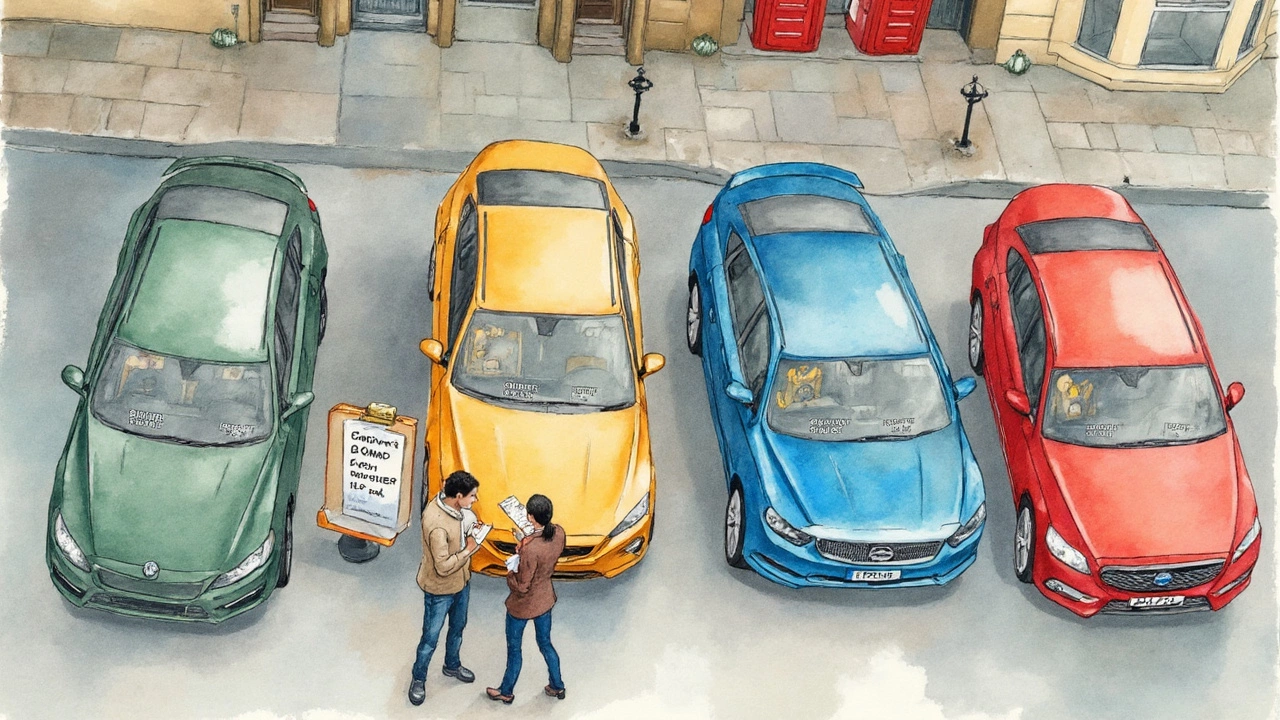Scrolling through listings for $20,000 cars? Most folks hear they should bring '20 percent down,' but is that real life or just old advice from your uncle? Today, the typical down payment sits around 10-15% for a new or used car. So, for a $20,000 car, you're looking at $2,000 to $3,000 upfront. Credit score, bank rules, and your own savings can shift that number up or down.
Now, here's something a lot of people miss: The more you pay up front, the less you owe, which means smaller monthly bills and less money lost to interest. Some lenders might smile at a bigger down payment too. But if cash is tight, putting less down isn't the end of the world—just don't forget, you’ll pay more each month, and you’re at a higher risk of owing more than the car’s worth if it loses value fast. Want to stretch your dollars? Keep reading for hacks and hidden traps worth knowing before you sign anything.
- How Much Do People Usually Put Down?
- How Down Payments Change Your Loan
- Tips for Saving Up Your Down Payment
- How Lenders See Your Down Payment
- Pitfalls to Avoid When Financing
How Much Do People Usually Put Down?
Let’s get straight to the numbers. For a $20,000 car, the old-school rule says you should cough up 20%—that’s $4,000. But here’s the deal: most people don’t do that anymore. According to recent data from Edmunds and Experian, the average down payment for new cars in the U.S. hovers around 12%-13% of the total price. On a $20,000 ride, that’s usually between $2,400 and $2,600. For used cars, it’s usually a bit lower—closer to 10% or even less.
| Type of Purchase | Average Down Payment (%) | Average Amount ($) |
|---|---|---|
| New Car | 12%-13% | $2,400-$2,600 |
| Used Car | 10%-11% | $2,000-$2,200 |
Why do so many people put less down these days? Bigger car prices, rising living costs, and lower interest rates mean buyers feel okay putting less money up front. If you’ve got solid credit, you might get away with a low down payment and still snag a decent deal. That said, going higher can save you a chunk of change in the long run.
Dealerships sometimes offer special deals—think $0 down or low-down-payment offers—to move inventory. But watch out: these promos can mean higher monthly bills or longer loan terms. If you’re worried about your credit or want to keep payments low, it’s worth running the numbers for 10%, 15%, and 20% down before making any move. That way, you know what fits your budget without getting blindsided at the finance office.
How Down Payments Change Your Loan
How much you put down on that $20000 car isn't just about making a good impression at the dealership—it actually shapes the whole vibe of your car finance deal. A higher average down payment lowers how much you have to borrow. It can slice hundreds or even thousands from the total interest you pay over the life of the loan.
Here’s how the math usually shakes out: Put down more and your monthly payment drops, because you’re financing less. Even better, your total interest (aka the profit for the lender) drops too. Let’s see how it looks in real life:
| Down Payment | Loan Amount | Monthly Payment* (5 years, 7% interest) | Total Interest Paid |
|---|---|---|---|
| $5,000 | $15,000 | $297 | $2,820 |
| $2,000 | $18,000 | $356 | $3,384 |
| $0 | $20,000 | $395 | $3,771 |
*Payment estimate—actual rates and offers can vary
Putting less or even zero down means higher payments. Not only that, you’ll probably pay more overall because the bank is charging interest on a bigger amount. Another trouble spot? If your car drops in value (which happens the second you drive off the lot), a small down payment could leave you “upside down”—owing more than the car's worth. That's a headache if you need to sell or if you get in an accident.
Another boost: some lenders throw better loan rates at buyers who cough up a bigger chunk up front. It’s a way to show you’re less risky, both for new and used cars. So, saving up for a stronger down payment can actually make a bigger difference than you might think on your auto loan.
Bottom line? Play with the numbers before you promise anything. Even a few extra bucks down could save you way more over the long haul. Use an auto loan calculator and see how down payment changes not just the monthly bill, but the entire deal.

Tips for Saving Up Your Down Payment
Building up a solid down payment for that $20,000 car might feel tough, but there are some real tricks that make it way more manageable. The key is to set a clear target amount—usually $2,000 to $3,000 if you’re aiming for that average 10-15% range. Mapping out a plan can cut the stress by half, seriously.
One simple but often ignored move is opening a separate savings account just for your car fund. When you stash money where you can’t touch it for impulse buys, saving goes a lot smoother. Most folks actually save faster when the cash isn’t mixed in with bills and daily spending. Apps like Ally, Capital One 360, or Chime let you set up savings sub-accounts with zero fees.
Set up automatic transfers straight from your main account on payday. Even $50 a week builds up quicker than you think, and you won’t even miss it after a while. Some people round up every card purchase to the next dollar and send the spare change to savings—many banks and apps let you do this on auto-pilot.
Cutting back on two or three small luxuries for a few months—like fast food, streaming extras, or buying coffee every day—can really stack up. If you skip a $4 coffee five times a week, that’s $80 a month heading toward your auto loan down payment fund instead.
- Sell extra stuff—old phones and unused gadgets can easily add up to a few hundred bucks on Facebook Marketplace or eBay.
- Pick up a temporary side hustle, like food delivery or pet-sitting. Even a weekend gig for a couple of months could give your car finance goal a serious boost.
- Tax refund season? Use all or part of your refund for your down payment. The IRS said the average refund in early 2024 topped $2,800—a nice chunk toward your goal.
| Monthly Savings | 6-Month Total |
|---|---|
| $100 | $600 |
| $250 | $1,500 |
| $500 | $3,000 |
If a family member wants to help, some lenders let you use gift money for your down payment. Just ask early, because there might be paperwork. And don’t forget—showing a bigger down payment can open up better deals or lower interest rates when it’s time to close that auto loan deal.
How Lenders See Your Down Payment
Lenders don’t just look at how much you want to finance—they care a lot about your average down payment too. The bigger it is, the less risky your loan looks to them. Why? If you put more cash into your $20,000 car up front, they know you’re serious, and if you stop paying, reselling the car covers more of the debt.
Banks and finance companies usually prefer buyers to pony up at least 10% of the car’s price. For a $20,000 ride, that’s $2,000. But if you put down 20%, or $4,000, you’ll often score better interest rates and a quicker approval. Some lenders offer lower rates, less paperwork, or even nicer perks to folks dropping a bigger down payment.
Ever heard of loan-to-value (LTV) ratio? It’s a key number for lenders. They calculate it by dividing the amount you’re borrowing by the value of the car. The lower that number, the happier the lender. A 90% LTV (meaning 10% down) is pretty common, but anything lower makes you look golden.
| Down Payment | Loan-to-Value (LTV) Ratio |
|---|---|
| $2,000 (10%) | 90% |
| $4,000 (20%) | 80% |
| $0 | 100% (or more, with taxes/fees) |
One big bank (Wells Fargo Auto) says it straight:
“Putting money down isn’t required, but a down payment can help you qualify for an auto loan and may even get you better terms.”
A bigger down payment for your car finance application makes lenders more confident in you, especially if your credit score is just so-so. Sometimes, it’s the difference between getting a yes or a nope. Plus, with less money to finance, you can save hundreds—sometimes thousands—over the life of the loan. So, before you sign any papers, ask the dealer or lender what kind of difference an extra $500 or $1,000 down could make for your monthly payments and interest rate. The answer might surprise you.

Pitfalls to Avoid When Financing
It’s easy to get swept up in the excitement of buying a car, but the wrong financing move can cost you serious money. Let’s break down the landmines to watch for when putting together your average down payment for a $20000 car—or really, any car.
- Stretching Out Loan Terms: A lower monthly payment sounds great, but 72-, 84-, or even 96-month loans mean you’re paying more interest—and for a lot longer. With long loans, you also run a higher risk of owing more than your car is worth (being upside down).
- Skipping the Down Payment: Some dealers hype $0 down offers, but that means you’re borrowing more. The result? Higher payments, more interest paid over the life of your loan, and a bigger risk if you need to sell or trade in early.
- Rolling Over Old Debt: If you still owe money on your last car, don’t just roll that balance into your new loan. Now you’re paying interest on old debt plus the new one, and your auto loan gets bigger than expected.
- Focusing Only on Monthly Payment: Dealers will try to steer you toward a monthly payment you can afford, but sometimes that comes with a longer loan or hidden fees. Look at the full picture—including total interest and fees.
- Not Knowing Your Credit Score: Your credit score is a huge deal in car finance. If you have a mid or low score, you’ll almost always get hit with higher rates. Check yours before you shop, and don’t assume the dealer will offer you the best rate. Shop around with banks or credit unions.
To see how loan term affects your wallet, here’s a simple breakdown for a $20,000 car, a 10% down payment, and the same interest rate:
| Loan Term | Monthly Payment | Total Interest Paid |
|---|---|---|
| 48 months | $443 | $1,273 |
| 60 months | $355 | $1,665 |
| 72 months | $302 | $2,078 |
Piling on extra years saves you a few bucks each month, but can cost you hundreds or even thousands in the long run. Get clear on what you can really afford both up front and over time before you sign anything. That’s how you get the car buying win—not just the new ride, but the peace of mind too.
